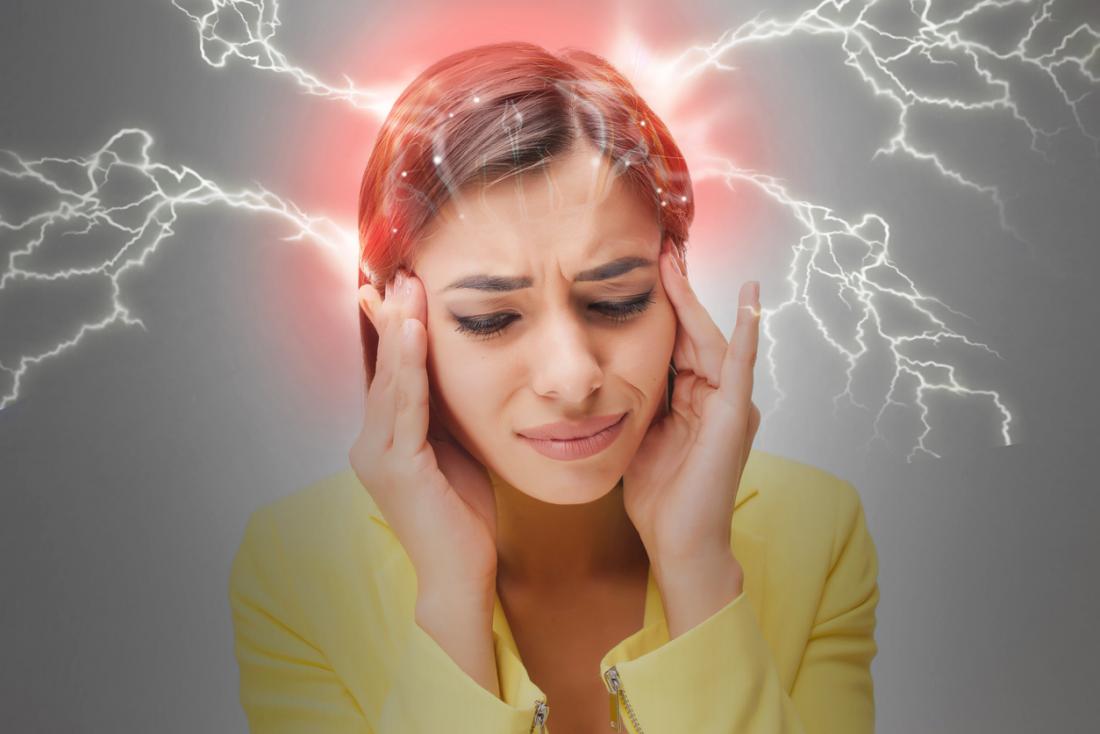The first time I experienced a migraine with aura, I was sitting in my high school physics class. I was grinding my way through a worksheet, eyelids heavy and sleep-deprived as usual, when a bright string of light appeared on the left side of my field of vision. I blinked hard, rubbed my eye, and waited for it to go away. But instead of dissipating, it grew and gradually wormed across my field of vision, a shimmery hairline crack in the fabric of my vision that distorted everything around it. I tried to keep working, but I couldn’t physically focus on anything. I couldn’t read. And when the floater finally crawled out of my eye, a splitting headache set in.
Migraines with aura, also called ocular migraines, bring about a special kind of pain, confusion, and fear. Sure, migraines are one thing, but I’d never heard of headaches that could affect vision. I was terrified; it sounds like exaggeration, but I legitimately thought I was going blind.
As strange as the experience sounds, and as frightening and isolating as it can be when it happens to you, migraines with aura are not uncommon. Of the population who gets migraines (about 39 million Americans alone), around 30 percent experience migraines with aura, said Susan Hutchinson, MD, director of the Orange County Migraine and Headache Center. That alone is somewhat comforting. What’s better: it also means that doctors have some idea of the causes, triggers, and treatments to make your migraines bearable.
Symptoms of Migraines With Aura
A migraine is an intense headache that can come along with nausea and sensitivity to light. The “aura” that some people experience along with it is broadly defined as a “set of neurological symptoms,” the most common of which is visual. “People can see things like bright, flashy lights that other people can’t see,” said Dr. Hutchinson, along with shimmering spots or zigzag lines, all of which are called “positive visual auras.” (Both “migraine with aura” and “ocular migraine” are used to describe this kind of migraine, but the former is considered more factual and is preferred by some doctors.)
You may also experience a “negative visual aura,” which means you might lose your vision temporarily. “Specifically, some people may have tunnel vision,” Dr. Hutchinson explained. “They can see in the middle but not out in the peripheries.” You could also experience blind spots, sometimes outlined by a geometric design.
You may also experience another scary symptom called dysphasia, which affects your power of speech. You might start slurring or garbling your words, or have trouble articulating. Other symptoms include muscle weakness or numbness that spreads across your hand or on one side of your face.
The key thing about migraines with auras is that your symptoms should pass within an hour. “If the aura lasts less than one hour and then the vision completely goes back to normal, that’s very, very reassuring,” Dr. Hutchinson said. If your migraines go longer than that, she recommended seeing a doctor or migraine specialist. If your vision in particular is still affected for over an hour, an optometrist can help you figure out if there’s something more serious going on with your eyesight. In general, if you experience symptoms of a migraine with aura, it’s recommended to see a doctor so you can rule out more serious conditions, like a stroke or tear in your retina.
What Causes a Migraine With Aura?
Not everyone experiences an aura with their migraines, but according to Dr. Hutchinson, the neurological activity is the same. In other words, doctors believe that people who don’t physically experience the aura still go through a “silent aura” phase. There’s nothing weird happening in your head, specifically, that causes an aura to happen to you and not someone else; it’s just that you’re more aware of it.
There are five phases of a migraine, Dr. Hutchinson told POPSUGAR: prodrome, aura, headache, and postdrome. You can think of prodrome as the “gearing up phase,” a time in which some people can tell that a migraine is coming; you might experience appetite changes, lethargy, or irritability. Then comes an aura, visual or otherwise, “which people may of may not experience clinically,” Dr. Hutchinson said, followed by the painful headache. Finally, there’s the “postdrome” phase, which might leave you feeling drained or confused for up to day, depending on the migraine’s severity.
The actual, neurological cause of migraines isn’t 100-percent understood, but Dr. Hutchinson explained that recent research has shown one common “pathway.” Migraines have been associated with elevated levels of a CGRP, a protein in your brain. CGRP is always present, but Dr. Hutchinson explained that during a migraine, its levels shoot upwards. “In people with chronic migraines, who have a headache more than 15 or more days a month, there’s some indication that their CGRP may be elevated all the time, even in between attacks,” she told POPSUGAR.
That’s what’s going on inside your brain, but what about outside of it? Migraines, including migraines with aura, are typically triggered by certain circumstances. According to Dr. Hutchinson, these can include:
- Stress
- Hormones (particularly for women, who are very prone to migraines between two days before and three days into their period)
- Lack of sleep
- Missing a meal
- Particular foods, especially with preservatives
How to Treat a Migraine With Aura
Identifying and limiting your exposure to your particular triggers is one of the most effective ways to prevent migraines, Dr. Hutchinson said. She recommended keeping a journal to record activities you did, foods you ate, and how much you slept in the 48 hours before a migraine hit. Were you under a lot of stress? Are you not getting enough sleep? Did you eat foods with gluten or preservatives like MSG, both of which can lead to migraines in people with sensitivities? “Often a migraine attack is caused by a combination of triggers coming together,” Dr. Hutchinson told POPSUGAR. Tracking your lifestyle around your migraines in the long-term can help you pick what the commonalities and make changes to lessen their frequency.
In my case, my migraines faded away after high school, probably because I was less stressed and started getting more sleep. But one migraine in college, which brought on not only a visual aura but also (for the first time) dysphasia symptoms, was painful and scary enough to keep me on the lookout for them ever since. I prioritize sleep in particular to keep them at bay.
If you’re experiencing a migraine in the moment, you can use several strategies to lessen the pain. Put them into practice as soon as you feel a migraine coming on, if possible. Here are a few that Dr. Hutchinson recommended:
- Turn off the lights.
- Lie down.
- Turn off the TV and any other stimuli.
- Drink water if you’re dehydrated.
- Put an ice pack on your forehead or neck.
- Take over-the-counter pain medications like aspirin, Tylenol, or ibuprofen.
For a more powerful treatment option, you can ask your doctor about triptans, which are prescriptions migraine-specific medications. Another prescription option: CGRP-blocking agents, injectable medications that are relatively new on the market and that work to prevent migraines by tamping down the amount of CGRP in your brain.
Talk to a doctor about what treatment or prevention option is right for your migraines. If you experience an aura with no migraine, Dr. Hutchinson recommended seeing an optometrist. There is no cure for migraines, Dr. Hutchinson said, but that doesn’t mean they’re inescapable. By working with a doctor and tracking your lifestyle, you can limit the frequency of your migraines to more manageable levels.
“The idea is to hopefully have your life back,” Dr. Hutchinson said. “You’re not tip-toeing around your migraines. You are getting up every morning and you’re being positive. And if you occasionally get a migraine, you’ve got a treatment that you know you can count on.”

